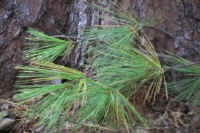
|
Paved Trail Page 1
16) 680 feet. Large northern red oak with a slight cant is adjacent to the trail on the right side. This is one of the largest trees along the trail with a height of 104 feet, and a cbh of 10.7 feet. Note the rough bark surface which is another indication of great age for the tree. Photos show the base of the tree as one approaches and red oak leaves. 17) 680 feet. This area also marks the boundary of an old field or pasture |
 |
18) 710 feet. In the old field section are grasses, apple trees, and several hawthorn trees which are not present in the wooded section. A distinct browse line can be seen where the deer graze and have removed the lower branches of all the trees and shrubs in the field. Whitetail deer are also largely responsible for the lack of much understory in the wooded section of the trail. An straggly apple tree is in the center of the picture. |

|
18a) Photograph of apples and leaves on one of the apple
trees in the old field
18b) Photograph of hawthorn (species not determined) showing the leaves and berries of the tree. 19) 755 feet. Wide area along the paved trail. the trail begins to turn back toward the parking area. |
 |
20) 790 feet. Japanese Barberry an invasive species likely grown from seeds distributed by birds from an ornamental planting. The bush has small round leaves, numerous sharp thorns, and red berries favored by many birds. It can spread and eventually dominate an area displacing native plant species. |

|
21) 900 feet. A northern red oak has broken off at a height
of around 15 feet. The trunk of the tree lies parallel to the
paved trail. At the time of these photographs, in early October,
surrounding the dead tree were masses of brightly colored Jack-o-lantern mushrooms
(non-edible). These are not perennials, but may come back for
several seasons. The visitor to the trail and the park need only
keep their eyes open to notice many similar displays of colorful fleshy
fungus throughout the growing season. In the winter wood bracket
fungus form dozens of little shelves on the sides of fallen and standing
dead trees. These features commonly go unnoticed by the casual
visitor.
22) 1005 feet. A wide area along the paved trail. |

|
23) 1075 feet. Northern red oak along the right side, about 30 feet off the trail. This tree has the largest diameter of any along the paved Trail with a cbh 11.1 feet and it stands about 100 feet tall. Views of the base of the tree and of the tree canopy. |
 |
24) 1170 feet. American beech tree, four feet from the
left side of trail. Height of 100 feet, and cbh 7.9 feet.
25) 1215 feet. A wide area along the paved trail. |
 |
26) 1250 feet. Northern red oak standing about 15 feet from right side of trail. |
 |
27) 1300 feet. Northern red oak on the left side of the trail. There is a major split in the tree at a height of about thirty feet. There the tree had formerly had two major trunks. The left of those trunks has since broken off and is lying on the ground beside the tree. |

|
28) 1350 feet. White pine along the right side of the paved trail. The tree measures 101.8 feet in height, and has a cbh of 5.3 feet. The tallest white pine in the park is measured at 181.3 feet tall and has a cbh of 11.1 feet. It is located in the Forest Cathedral Area of the park. View shows the base of this thin tall tree and a close-up of the needles from the white pine. |
| 29) 1436 feet. Intersection with the trail at
the beginning of the loop.
Text and photographs by Edward Frank. Height and cbh measurements by Dale Luthringer. copyright 2003 Edward Forrest Frank |





